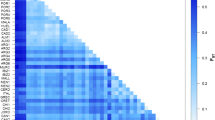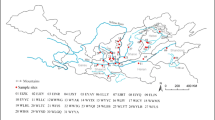Abstract
Enzyme electrophoresis was used to estimate genetic diversity and population structure of Juniperus rigida (Cupressaceae) and Juniperus coreana in Korea. In J. rigida, 16 of the 22 loci (72.7%) showed detectable polymorphism. Genetic diversity (0.224) was higher than average values for species with similar life history traits. The endemic species (J. coreana) was found to have fewer alleles per locus (1.39 vs. 1.61), fewer alleles per polymorphic locus (2.42 vs. 2.63), lower percent polymorphic locus (54.6 vs. 72.7%), and lower diversity (0.199 vs. 0.224) than J. rigida. These genetic diversity parameters indicated that J. coreana was genetically depauperate relative to its presumptive progenitor, J. rigida. Analysis of fixation indices showed a substantial deficiency of heterozygotes relative to Hardy–Weinberg expectations suggesting inbreeding in J. coreana. The G ST values of J. rigida and J. coreana were 0.173 and 0.118 respectively. The indirect estimate of gene flow based on mean G ST was moderate (Nm = 1.19 for J. rigida and 1.86 for J. coreana).
Similar content being viewed by others
References
Barton, N.H. and Slatkin, M. (1986) A quasi–equilibrium theory of the distribution of rare alleles in a subpopulation. Heredity 56, 409–415.
Bennett, M.D. and Leich, I.J. (1995) Nuclear DNA amount in angiosperms. Ann. Botany 76, 113–176.
Brown, A.H.D. (1979) Enzyme polymorphism in plant populations. Theor. Popul. Biol. 15, 1–42.
Charlesworth, D. and Charlesworth, B. (1995) Quantitative genetics in plants: the effect of the breeding system on genetic variability. Evolution 49, 911–920.
Charlesworth, D. and Mayer, S. (1994) Genetic variability of plant characters in the partial inbreeder Collinsia heterophylla (Scrophulariaceae). Am. J. Botany 82, 112–120.
Crawford, D.J. (1983) Phylogenetic and systematic inferences from electrophoretic studies. In S.O. Tanksley and T.J. Orton (eds) Isozymes in Plant Genetics and Breeding. Elsevier Science, Amsterdam, pp. 357–287.
Crow, J.K. and Felsenstein, J. (1968) The effect of assortative mating on the genetic composition of a population. Eugenetics Quart. 15, 85–97.
Ellstrand, N.C. and Roose, M.L. (1987) Patterns of genotypic diversity in clonal plant species. Am. J. Botany 74, 123–131.
Godt, M.J.W. and Hamrick, J.L. (1998) Allozyme diversity in the endangered pitcher plant Saracenia rubra ssp. alabamensis (Sarraceniaceae) and its close relative S. rubra ssp. rubra. Am. J. Botany 85, 802–810.
Gottlieb, L.D. (1981) Electrophoretic evidence and plant populations. Prog. Phytochem. 7, 1–46.
Hamrick, J.L. and Godt, M.J.W. (1989) Allozyme diversity in plant species. In A.D.H. Brown, M.T. Clegg, A.L. Kahler and B.S. Weir (eds), Plant Population Genetics, Breeding and Genetic Resources. Sinauer Press, Sunderland, pp. 304–319.
Hamrick, J.L., Godt, M.J.W., Murawski, D.A. and Loverless, M.D. (1991) Correlations between species traits and allozyme diversity: implications for conservation biology. In D.A. Falk and K.E. Holsinger (eds) Genetics and Conservation of Rare Plants. Oxford University Press, New York, pp.75–86.
Hamrick, J.L., Godt, M.J.W. and Sherman–Broyles, S.L. (1992) Factors influencing levels of genetic diversity in woody plant species. New Forests 6, 95–124.
Hartnett, D.C. and Bazzaz, F.A. (1985) The regulation of leaf, ramet and gene densities in experimental populations of the rizomatous perennial Solidago canadensis. J. Ecol. 73, 429–443.
Huenneke, L.F. (1991) Ecological implications of variation in plant populations. In D.A. Falk and K.E. Holsinger (eds) Genetics and Conservation of Rare Plants. Oxford University Press, New York, pp. 31–44.
Huh, M.K., Chung, S.D. and Huh, H.W. (1998) Allozyme variation and population structure of Pyrola japonica in Korea. Bot. Bull. Academia Sinica 39, 107–112.
Karron, J.D. (1987) A comparison of levels of genetic polymorphic and self–compatibility in geographically restricted and widespread plant congeners. Evol. Ecol. 1, 47–58.
Kim, T.J. (1996) Korean Resources Plants. Seoul University Press, Seoul, Korea.
Ledig, F.T. (1986) Heterozygosity, heterosis, and fitness in outbreeding plants. In M.E. Soule (ed.) Conservation Biology. Sinauer Sunderland, MA, pp. 77–104.
Li, C.C. and Horvitz, D.G. (1953) Some methods of estimating the inbreeding coefficient. Am. J. Human Genetics 5, 107–117.
Loveless, M.D. and Hamrick, J.L. (1984) Ecological determinants of genetic structure in plant populations. Ann. Rev. Ecol. Systemat. 15, 65–95.
Nei, M. (1972) Genetic distance between populations. Am. Nat. 106, 282–292.
Nei, M. (1973) Analysis of gene diversity in subdivided populations. Proc. Nat. Acad. Sci., USA 70, 3321–3323.
Peasants, J.M. and Wendel, J.F. (1989) Genetic diversity in a clonal narrow endemic, Erythronium propullans, and its widespread progenitor, Erythronium albidum. Am. J. Botany 76, 1136–1151.
Purdy, B.G., Bayer, R.J. and Macdonald, S.E. (1994) Genetic variation, breeding system evolution, and conservation of the narrow sand dune endemic Stellaria arenicola and the widespread S. longipes (Caryphyllaceae). Am. J. Botany 81, 904–911.
Purdy, B.G. and Bayer, R.J. (1995) Genetic diversity in the tetraploid sand dune endemic Des–champsia mackenzieana and it widespread diploid progenitor D. cespitosa (Poaceae). Am. J. Botany 82, 121–130.
Qiu, Y.L. and Parks, C.R. (1994) Disparity of allozyme variation levels in three Magnolia (Magnoliaceae) species from the southeastern United States. Am. J. Botany 91, 1300–1308.
SAS Institute Inc. (1989) SAS/STAT user's guide, Ver. 6, 4th edn. Vol 1. SAS Institute. Cary.
Schnabel, A. and Hamrick, J.L. (1990) Organization of genetic diversity within and among populations of Gledista triacanthos (Leguminosae). Am. J. Botany 77, 1060–1069.
Sherman–Broyles, S.L., Broyles, S.B. and Hamrick, J.L. (1992) Geographic distribution of allozyme variation in Ulmus crassifolia. Systematic Botany 17, 33–41.
Slatkin, M. (1985) Rare alleles as indicators of gene flow. Evolution 39, 53–65.
Smouse, P.E., Long, J.C. and Sokal, R.R. (1986) Multiple regression and correlation extensions of the Mantel test of matrix correspondence. Systematic Zoology 35, 627–632.
Soltis, D.E., Haufler, C.H., Darrow, D.C. and Gastony, G.J. (1983) Starch gel electrophoresis of ferns: a compilation of grinding buffers, gel and electrode buffers, and staining schedules. Am. Fern J. 73, 9–27.
Vogelmann, J.E. and Gastony, G.J. (1987) Electrophoretic enzyme analysis of North American and eastern Asian populations of Agastache sect. Agastache (Labitatae). Am. J. Botany 74, 385–393.
Weeden, N.F. and Wendel, J.F. (1989) Genetics of plant isozymes. In D.E. Soltis and P.S. Soltis (eds) Isozymes in Plant Biology, Dioscorides Press, Portland, pp. 42–72.
Williamson, P.S. and Werth, C.R. (1999) Levels and patterns of genetic variation in the endangered species Abronia macrocarpa (Nyctaginaceae). Am. J. Botany 86, 293–301.
Woodland, D.W. (1991) Contemporary Plant Systematics. Prentice–Hall, Inc., Englewood Cliffs, NJ.
Workman, P.L. and Niswander, J.D. (1970) Population studies on southern Indian tribes. II. Local genetic differentiation in the Papago. Am. J. Human Genetics 22, 24–49.
Wright, S. (1951) The genetical structure of populations. Ann. Eugenics 15, 323–354.
Wright, S. (1965) The interpretation of population structure by F–statistics with special regard to systems of mating. Evolution 19, 395–420.
Author information
Authors and Affiliations
Corresponding author
Rights and permissions
About this article
Cite this article
Huh, M.K., Huh, H.W. Genetic Diversity and Population Structure of Juniperus rigida (Cupressaceae) and Juniperus coreana. Evolutionary Ecology 14, 87–98 (2000). https://doi.org/10.1023/A:1011090013749
Issue Date:
DOI: https://doi.org/10.1023/A:1011090013749




